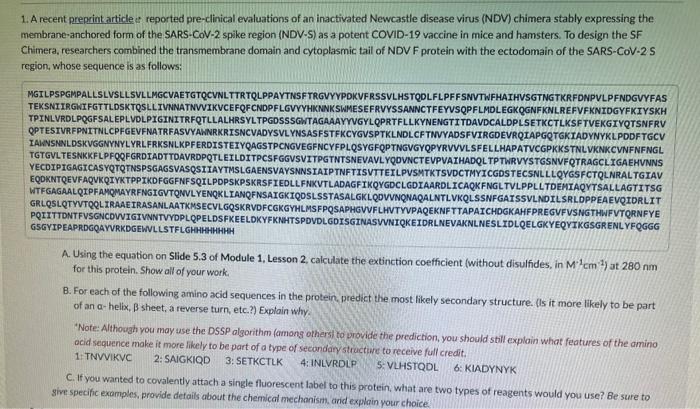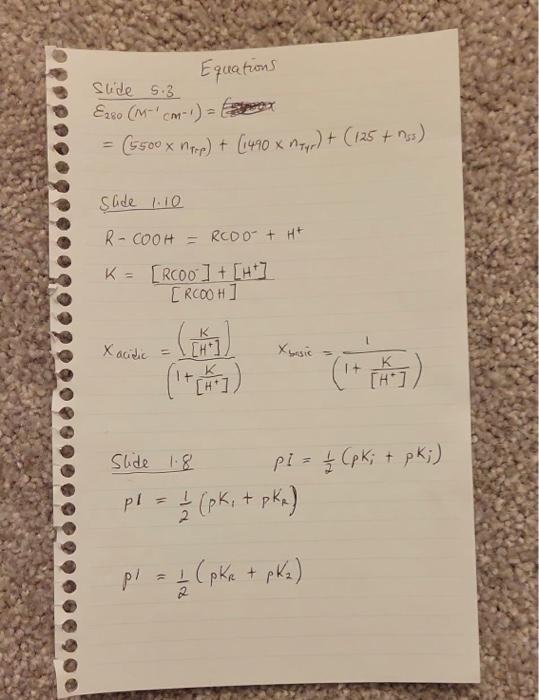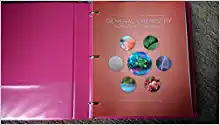1. A recent preprint articles reported pre-clinical evaluations of an inactivated Newcastle disease virus (NDV) chimera stably expressing the membrane-anchored form of the SARS-CoV-2 spike region (NDV-S) as a potent COVID-19 vaccine in mice and hamsters. To design the SF Chimera, researchers combined the transmembrane domain and cytoplasmic tail of NDVF protein with the ectodomain of the SARS-CoV-2 S region, whose sequence is as follows: MGILPSPGMPALLSLVSLLSVLLMGCVAETGTQCVNLTTRTOLPPAYTNSF TRGVYYPDKVFRSSVLHSTOOLFLPFFSNVTWFHAIHVSGTNGTKRFDNPVLPFNDGVYFAS TEKSNI IRGWIFGTTLDSKTQSLLIVNNATNVVIKVCEFQFCNDPFLGVYYHKNNKSWMESEFRVYSSANNCTFEYVSQPFLMDLEGKOGNFKNLREFVFKNIDGYFKIYSKH TPINLVRDLPQGFSALEPLVOLPIGINITRFQTLLALHRSYLTPGDSSSGWTAGAAAYYVGYLQPRTFLLKYNENGTI TDAUDCALDPLSETKCTLKSFTVEKGIYOTSNFRV OPTESTVRFPNITNLCPFGEVFNATRFASVYAWNRKRISNCVADYSVLYNSASFSTEKCYGVSPTKLNDLCFTNVYADSFVIRGDEVRQIAPGQTGKIADYNYKLPDDFTGCV LAWNSNNLDSKVGGNYNYLYRLFRKSNLKPFERDISTETYQAGSTPCNGVEGFNCYFPLQSYGFQPTNGVGYQPYRVVVLSFELLHAPATVCGPKKSTNL VENKOVNENENGL TGTGVLTESNKKFLPFQQFGRDIADTTOAVRDPQTLEILDITPCSFGGVSVITPGTNTSNEVAVLYQOVNCTEVPVAIHADOL TPTWRVYSTGSNVFQTRAGCLIGAEHVNNS YECDIPIGAGICASYQTQTNSPSGAGSVASQSIIAYTMSLGAENSVAYSNNSIAIPTNFTISVTTEILPVSMTKTSVDCTMYICGOSTECSNL LLOYGSFCTQLNRALTGIAV EQDKNTQEVFAQVKQIYKTPPIKDFGGFNFSQILPDPSKPSKRSFIEDLLFNKUTLADAGFIKQYGDCLGDIAARDLICAQKFNGLTVLPPLLTDEMTAQYTSALLAGTITSG WTFGAGAALQIPFAMQMAYRFNGIGVTONVLYENQKLIANQFNSAIGKIQOSLSSTASALGKLQOVUNQNAQALNTLVKQLSSNFGAISSVLNDILSRLOPPEAEVQIDRLIT GRLQSLQTYVTQQLIRAAE IRASANLAATKMSECVLGQSKRVDFCGKGYHLMSFPQSAPHGVVFLHVTYVPAQEKNFTTAPAICHDGKAHFPREGVFVSNGTHWFVTORNFYE PQIITTONTEVSGNCOVVIGIVNNTVYDPLQPELDSFKEELDKYFKNHTSPDVDLGDISGINASVUNIQKEIDRLNEVAKNLNESLIDLQELGKYEQYTKGSGRENLYFQGGG GSGYIPEAPROGQAYVRKDGEWVLLSTFLGHHHHHHHH A. Using the equation on Slide 5.3 of Module 1. Lesson 2. calculate the extinction coefficient (without disulfides, in M?cm) at 280 nm for this protein. Show all of your work. B. For each of the following amino acid sequences in the protein predict the most likely secondary structure. Is it more likely to be part of an a-helix, B sheet, a reverse turn, etc.?) Explain why "Note: Although you may use the DSSP algorithm (among others to provide the prediction, you should still explain what features of the amino acid sequence make it more likely to be part of a type of secondary structure to receive full credit 1. TNVVIKVC 2: SAIGKIQD 3: SETKCTLK 4: INLVRDLP 5:VLHSTQDL 6: KIADYNYK C. If you wanted to covalently attach a single fluorescent label to this protein, what are two types of reagents would you use? Be sure to give specific examples, provide details about the chemical mechanism, and explain your choice Slide 5.3 Equations E280 (M-'cm) - (5500 X harp) + (1490 x T) + (125 + Ass) Slide 1.10 R-COOH = RCoo- + H+ K= [Rcoo ] + [4] [RCOOH X acidic Xysic ('+ [H] Slide 1.8 pi= + (pki + pk;) = 1 / 2 (pk, + pke) pl 2 pl = 1 (pka + pka) 2 1. A recent preprint articles reported pre-clinical evaluations of an inactivated Newcastle disease virus (NDV) chimera stably expressing the membrane-anchored form of the SARS-CoV-2 spike region (NDV-S) as a potent COVID-19 vaccine in mice and hamsters. To design the SF Chimera, researchers combined the transmembrane domain and cytoplasmic tail of NDVF protein with the ectodomain of the SARS-CoV-2 S region, whose sequence is as follows: MGILPSPGMPALLSLVSLLSVLLMGCVAETGTQCVNLTTRTOLPPAYTNSF TRGVYYPDKVFRSSVLHSTOOLFLPFFSNVTWFHAIHVSGTNGTKRFDNPVLPFNDGVYFAS TEKSNI IRGWIFGTTLDSKTQSLLIVNNATNVVIKVCEFQFCNDPFLGVYYHKNNKSWMESEFRVYSSANNCTFEYVSQPFLMDLEGKOGNFKNLREFVFKNIDGYFKIYSKH TPINLVRDLPQGFSALEPLVOLPIGINITRFQTLLALHRSYLTPGDSSSGWTAGAAAYYVGYLQPRTFLLKYNENGTI TDAUDCALDPLSETKCTLKSFTVEKGIYOTSNFRV OPTESTVRFPNITNLCPFGEVFNATRFASVYAWNRKRISNCVADYSVLYNSASFSTEKCYGVSPTKLNDLCFTNVYADSFVIRGDEVRQIAPGQTGKIADYNYKLPDDFTGCV LAWNSNNLDSKVGGNYNYLYRLFRKSNLKPFERDISTETYQAGSTPCNGVEGFNCYFPLQSYGFQPTNGVGYQPYRVVVLSFELLHAPATVCGPKKSTNL VENKOVNENENGL TGTGVLTESNKKFLPFQQFGRDIADTTOAVRDPQTLEILDITPCSFGGVSVITPGTNTSNEVAVLYQOVNCTEVPVAIHADOL TPTWRVYSTGSNVFQTRAGCLIGAEHVNNS YECDIPIGAGICASYQTQTNSPSGAGSVASQSIIAYTMSLGAENSVAYSNNSIAIPTNFTISVTTEILPVSMTKTSVDCTMYICGOSTECSNL LLOYGSFCTQLNRALTGIAV EQDKNTQEVFAQVKQIYKTPPIKDFGGFNFSQILPDPSKPSKRSFIEDLLFNKUTLADAGFIKQYGDCLGDIAARDLICAQKFNGLTVLPPLLTDEMTAQYTSALLAGTITSG WTFGAGAALQIPFAMQMAYRFNGIGVTONVLYENQKLIANQFNSAIGKIQOSLSSTASALGKLQOVUNQNAQALNTLVKQLSSNFGAISSVLNDILSRLOPPEAEVQIDRLIT GRLQSLQTYVTQQLIRAAE IRASANLAATKMSECVLGQSKRVDFCGKGYHLMSFPQSAPHGVVFLHVTYVPAQEKNFTTAPAICHDGKAHFPREGVFVSNGTHWFVTORNFYE PQIITTONTEVSGNCOVVIGIVNNTVYDPLQPELDSFKEELDKYFKNHTSPDVDLGDISGINASVUNIQKEIDRLNEVAKNLNESLIDLQELGKYEQYTKGSGRENLYFQGGG GSGYIPEAPROGQAYVRKDGEWVLLSTFLGHHHHHHHH A. Using the equation on Slide 5.3 of Module 1. Lesson 2. calculate the extinction coefficient (without disulfides, in M?cm) at 280 nm for this protein. Show all of your work. B. For each of the following amino acid sequences in the protein predict the most likely secondary structure. Is it more likely to be part of an a-helix, B sheet, a reverse turn, etc.?) Explain why "Note: Although you may use the DSSP algorithm (among others to provide the prediction, you should still explain what features of the amino acid sequence make it more likely to be part of a type of secondary structure to receive full credit 1. TNVVIKVC 2: SAIGKIQD 3: SETKCTLK 4: INLVRDLP 5:VLHSTQDL 6: KIADYNYK C. If you wanted to covalently attach a single fluorescent label to this protein, what are two types of reagents would you use? Be sure to give specific examples, provide details about the chemical mechanism, and explain your choice Slide 5.3 Equations E280 (M-'cm) - (5500 X harp) + (1490 x T) + (125 + Ass) Slide 1.10 R-COOH = RCoo- + H+ K= [Rcoo ] + [4] [RCOOH X acidic Xysic ('+ [H] Slide 1.8 pi= + (pki + pk;) = 1 / 2 (pk, + pke) pl 2 pl = 1 (pka + pka) 2








